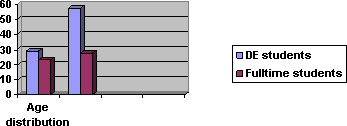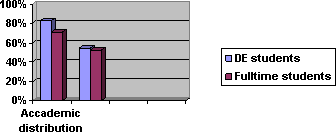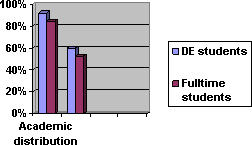|
The impact of Video Conferencing on Distance Education: A University of Namibia Case Study
Trudie Frindt
Continuing Education
Abstract
Recently, there has been explosive growth in the array of distance learning delivery modes and information technologies. Interactive video and audio conferencing as well as telephone tutoring have made it possible for distance education to move into the forefront of course delivery. The University of Namibia has been using interactive video conferencing and teleconferencing techniques to enhance leaning amongst its distance education students during the past few years.
This paper will present the results of a study, which will evaluate the examination results of three groups of students who are enrolled in Business Mathematics at the University of Namibia. Business Mathematics is a course on the Bachelor of Education that is offered both through open and distance learning, and through the conventional full time mode. Group A as fulltime students would received instruction through the conventional lecturing mode, while Group B will be taught through the means of distance education designed study materials. Group C would receive instruction through the distance education designed study material complemented by video conferencing.
The research design will follow a quantitative research method whereby test and examination results of the three groups will be analysed and compared. The aim of the study is to determine the impact of the three delivery methods on the academic performance of the above-mentioned groups.
The impact of Video Conferencing on Distance Education:
According to The Centre for External Studies (CES) at the University of Namibia (UNAM), CES's Policy on Open and Distance Learning is committed to provide accessible and quality higher education through flexible and mixed mode approaches to its students and the community at large. In providing an enabling environment and leadership through innovative teaching methods, CES has enabled the University to increase its student numbers of distance education students to 45% of the total number of UNAM student, making UNAM a dual mode institution (CES policy document:2005).
This case study describes the effectiveness and impact of video conferencing and other interactive technologies on the performances of 38 distance education students who enrolled for their final year course in one of the two teaching methods subjects namely, teaching Methods of Business Studies and teaching Methods of Economics.
This research had its origin in 2005 when the above mentioned students were informed that there was no study material available for the two subjects which had the implication that they would not be able to sit for their final exam in November 2005. Knowing what effect that could have on student performances, CES sought help from the fulltime lecturer on campus, but soon discovered that the fulltime students only made use of handouts and class notes. The next best thing was to concentrate on video conferencing as the majority of students lived close enough to the northern campus which is located at Oshakati and which is predominantly serving the four northern regions Omusati, Ohangwena, Oshana and Oshikoto. According to the official statistics of 2001, the total population of Namibia in 2001 was 1,830,330 of which 780,149 lived in the four northern regions. This equals 42,6% of the total population. Nearly half of the Namibian population is thus potentially served by the northern campus, which was established during 1996 with the financial support of the Ford Foundation. One of the main reasons for the establishment of the campus was to support UNAM distance education students who resided in the four northern regions. It was therefore necessary to enhance the educational experience by allowing the distance education students to interact with the expertise that was available at the main campus.
Since distance acquisition of knowledge is often an expensive and time-consuming process to institute and maintain, Cavanaugh (2001:75) rightly states that it is important to know whether distance education actually improves student performance and which distance education delivery methods and techniques are more effective, “so students get maximum benefit from society's investment in distance learning technology”. This study will therefore discuss the effectiveness and interactivity of video conferencing on a group of distance education students at the Oshakati northern campus, who had to rely on interactive video conferencing to prepare them for their end of the year examination.
While research on technology-enhanced learning dates back to the beginning of the last century (De Vaney & Butler 1996), research on video conferencing in Namibia is still in its infancy. Sherry (1996); Alhalabi, Anadaptuam, & Hamza, (1998); Cavanaugh (2001); Heath and Holznagel, (2002) and Amirian, (2002), point out the unique ability of video conferencing to promote interaction in the classroom. If the course encourages interactions, active learning models that follow the social constructivist model of Vygotsky (1978) predict that successful learning is likely to result. These learning models require students to construct their own knowledge in a self-directing manner and to take on more responsibility for their own learning.
Holmberg's theory of distance teaching (1985) states that distance teaching will support student motivation and promote learning pleasure and effectiveness if learners are engaged in discussions and decisions, and the programme provides for real and simulated communication to and from the students Cavanaugh (2001:75). As in any classroom, interaction is the core of teaching. Distance education is believed to work very well, and produce results as effective as tradition classroom instruction (Kearsley, 1996:55-58). However, the distance education currently in practice has the potential to provide more effective learning with updated pedagogy, more experience, and greater understanding and knowledge of methods. Moore and Thompson (1990) suggested that improved distance education practices have the potential to enhance educational outcomes, especially when the amount and kind of learner interaction is increased and there is student to student interaction and teacher to student feedback. Wagner (1998:417) reported that distance learning practitioners tend to view interaction as the “single most significant attribute that defines a contemporary distance learning experience”. Gilbert and Moore (1998:29-35) note that an accepted definition of interactivity in the literature on computer-mediated instruction is a reciprocal exchange between the technology and the learner, a process which they say is referred to as “feedback.”
For Sherry (1996), interactivity takes many forms; it is not just limited to audio and video, nor solely to teacher-student interactions. It represents the connectivity the students feel with the distance education lecturer, the facilitators and their peers. Sherry (1996) states that without connectivity, distance learning degenerates into the old correspondence course model of independent study. The student becomes autonomous and isolated, and eventually drops out. She argues that effective distance education should not be independent and isolated from learning, but should approach Keegan's ideal of an authentic learning experience.
In a well researched literature review on video conferencing, Amirian (2002) found that interaction is critical to any video conferencing-based learning situation. She argues that video conferencing should be used in ways that make full use of its unique qualities. Specifically, she says, “interaction is the key component of this use of the technology to support a more social learning, negotiating meaning through interaction”. Echoing Amirian's point about interaction, Irele (1999) finds that video conferencing enables remote learners to be part of a social and socialising environment. Irele concludes in his comparative analysis that in a video conferencing-based learning situation, a combination of media “increases the chances of positive learning outcomes by increasing the range of learning styles that can be accommodated”.
Also suggesting the importance of video conferencing ability to accommodate different learning styles are Heath and Holznagel (2002) and Alhalabi, Anadaptuam & Hamza (1998:2). These authors are of the opinion that using several technologies to meet different instructional needs and learning styles results in a richer, more effective instructional experience. According to them both synchronous and asynchronous communications types are ideal in distance education because it produces interactivity. An essential challenge of a distance learning course is promoting and sustaining interactivity.
This case study describes the effectiveness and impact of video conferencing and other interactive technologies on the performances of 38 distance education students who enrolled for the Bachelor of Education Degree. Although it was not the purpose of the research to compare the examination results of the two distance education groups with that of the full time students on campus, (because they had different lecturers and also wrote different examination papers), the researcher saw it as a further opportunity to prove what impact video conferencing had on the performance of distance students when comparing them to their full-time counterparts.
For the purpose of this Case study, a qualitative method was employed. Results of the design are outlined as indicated below:
a) A literature review with particular reference to the interactivity of video conferencing was made.
Personal interviews with the student support staff at UNAM as well as with the lecturer who was responsible for the video conferencing.
End of the year examination results of distance education as well as full time student's results were obtained and compared to support the study.
The research design followed a qualitative approach where descriptive statistics were applied.
The sample considered in this study consisted of 38 distance education students of which 16 enrolled for the course in Teaching Methods of Economic and 22 for the Teaching Methods of Business Studies. The language of instruction was English and for all students this was their second language.
The study was done by means of personal interviews with the student support staff at UNAM, as well as interviews and various discussions with the lecturer who was responsible for the video conferencing.
The research participants were 38 undergraduate distance education students who enrolled for the course in Teaching Methods of Economic and Teaching Methods of Business Studies. As mentioned earlier, it was decided to use interactive video conferencing classes when we realised that students were not going to have their study material in time to prepare them for the end of the year examination. Student support staff at the main campus traced the students and informed them about the video conferencing classes that were going to be held over a period of one month to eliminate the problem. Since 32 of the students resided in the northern regions, it was possible to organise video conferencing classes because it was much closer for the students to go to the northern campus than to travel to Windhoek. The remaining 6 students were living close to the main campus and were able to travel to Windhoek every Tuesday and Thursday. A survey was therefore conducted to determine how many students had access to e-mail, facsimile, cell phone or telephone facilities.
The lecturer responsible for the video conferencing class would e-mail handouts to those students who had access to the Internet and at the same time e-mail notes to the student support staff at CES to distribute notes to those who had access to fax facilities. Staff would also phone students reminding them about classes and informing them where to pick up their class notes to prepare them for their next video conference class. During this one month period students wrote class tests, which were invigilated by staff from the northern campus and were collected and posted the following morning to the main campus. Assignments were faxed, e-mailed or brought to the northern campus to be posted to CES.
The following quotation provides something of the flavour of the personal involvement that the lecturer had with the students:
I also spent a lot of time on the telephone with the students. I encouraged them all to write to me, and I encouraged them to phone me if they had a problem. If they were not sure about their assignments, I told them to send me what they've got, and I would tell them if they're on the right track (Interview with lecturer, July 2006).
The end of the year results of this one-month interactive video conferencing and other technology based support for the two distance education groups was satisfactory to say the least.
Table 1 indicates the distribution of age amongst the two groups of students (distance education and fulltime students) who enrolled for the course in Teaching Methods of Economics.
TEACHING METHODS OF ECONOMICS.
Table 1: Age and gender distribution of distance and fulltime students.
11 of the 16 distance education students were female, while 5 were male. Their ages ranged from 29 to 57 years of age. Of the 19 students who enrolled on a full-time basis, 9 were male while 10 were female. Their ages ranged from 23 to 28 with the average age being 25. Table 2 illustrates the comparison in their academic performances.
Table 2: Distribution of academic performances of distance and fulltime students.
When comparing the examination results of the distance education students with that of the fulltime students, it was surprising to find that the distance education students scored much higher in the examination than their fulltime counterparts. Their highest score was 83% with an average of 72%, while the highest score of fulltime students were 71% with an average of 65,2%.
It is also worth mentioning that all 16 distance education students passed while 5 obtained distinctions, whereas three of the fulltime students failed. This statistics is in line with research done here and elsewhere that there is a positive correlation between age and successes, i.e., older students do better than younger ones (Rakkedal, 1998). This being the case, it is clear that at the very least video conferencing did not prejudice these students' chances of succeeding.
In general, and according to our own experiences, adult students who are well established in a working situation with family and children, succeed better than younger students with fewer vocational, family, social and economic responsibilities.
TEACHING METHODS OF BUSINESS STUDIES
When looking at the course in Teaching Methods of Business Studies, we found that of the 22 distance education students who enrolled for the course only 2 were male, while the remaining 20 students were female. Their ages ranged from 32 to 58, with the average age being 42 years. Strangely enough the same number of fulltime students enrolled for the course. Their ages ranged from 22 to 30 with the average age being 26. Five of the 22 students were male while 17 were females. Table 3 illustrates the academic performances of the two groups of students.
Table 3: Distribution of academic performances of distance and fulltime students.
As with the previous subject, all distance education students passed while 7 students obtained 80% and higher. Although there were two fulltime students who obtained 80% and higher, 4 of the 22 students failed the course.
The traditional distance education student within the Namibian context has been that of a remote student, an independent learner, with a standalone package of study materials. However the findings of this case study reveal that teaching and studying at a distance can be as effective as traditional instruction since the methods and technologies used were appropriate to the instructional tasks and there have been numerous occasions of interaction between student and lecturer as well as between the student themselves. This study also proofed that instruction can be successful if lecturers identify themselves with the needs of their students.
In the light of the above-mentioned successes, the researcher would therefore like to recommend that video conferencing be used on a more regularly bases and that funding be sought to equip all 9 UNAM centres with this kind of interactive technology.
Alhalabi, B., Anadaptuam, S., & Hamza, M. (1998). Real laboratories: An innovative rejoinder to the complexities of distance learning. Journal of Open Praxis, 24-30.
Amirian, S. (2003). “Pedagogy and Video conferencing: A Review of Recent Literature,” In: Greenberg, A. Navigating the Sea of Research on Video conferencing-Based Distance Education. Wainhouse Research, Polycom, Inc. February 2004.
Cavanaugh, C.S, (2001). The Effectiveness of Interactive Distance Education Technologies in K-12 Learning. International Journal of Educational Telecommunications, 7 (1), 73-88.
De Vaney, A., & Butler, R.O. (1996). Voices of the Founders: Early Discourse in Technology. Handbook of Research for Educational Communications and Technology. D. H Jonassen (ed.), Simon and Schuster Macmillan, New York.
Gilbert, L., & Moore, D.R. (1998). Building interactivity into web courses: Tools for social and instructional interaction. Educational Technology, 38 (3), 29-35.
Heath, M.J. & Holznagel, D. (2002). “Interactive Video conferencing: A Literature Review,” NECC, June 2002.
Irele, Modupe .(1999). “Relative Effectiveness of Distance Learning Systems,” Lucent Technologies and the World Campus, Pennsylvania State University Press, 1999.
Kearsley, G. (1996). Education as usual: Comments on Chris Dede's article. The American Journal of Distance Education, 10 (2), 55-58.
Moore, M.G., & Thompson, M.M. (1990). The effects of distance learning: A summary of literature (Research Monograph No. 2). University Park, PA: American Center for the Study of Distance Education.
Rekkedal, T. (1998). “Quality Assessment and Evaluation: Basic Philosophies, Concepts and Practices at NKI, Norway”, in Evaluation Concepts and Practice in Selected Distance Education Institutions, Edited by H. Rathmore and R. Schuemer. Hagen, Norway: Fern Universitat.
Sherry, L. (1996). Issues in Distance Learning. International Journal of Educational Telecommunications, 1 (4), 337-365.
Vygotsky, L.S. (1978). Mind in Society. Cambridge, MA: Harvard University Press.
Wagner, E. (1998). Interaction strategies for online training designs. Paper presented at the Annual Conference on Distance Teaching & Learning, Madison, WI.
Figures
Table 1: Age and gender distribution of distance and fulltime students.

Table 2: Distribution of academic performances of distance and fulltime students.

Table 3: Distribution of academic performances of distance and fulltime students.

|
 |
Learn more
about this
publishing
project...
|
|

